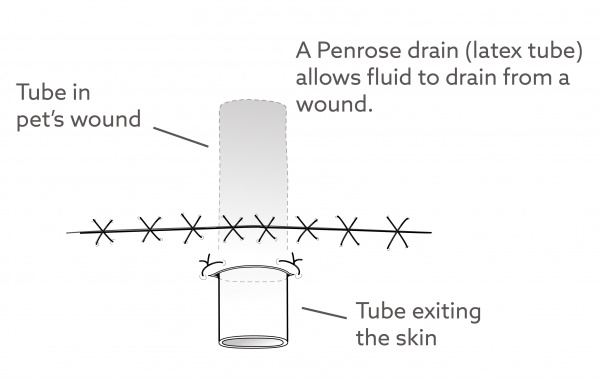Penrose Drain Discharge Instructions for Dogs
What is a Penrose drain?
A Penrose drain is a latex tube that is placed into a wound with one or two ends exiting the skin, allowing fluids to drain from the wound. The drain is typically sutured to the skin to hold the drain in place. Most likely, the drain will exit from a new incision site and not the primary wound site.
What is the purpose of the Penrose drain?
The Penrose drain is designed to passively remove unwanted fluid, usually when treating abscesses or open wounds. Abscesses (pockets of pus/infection) and open wounds are considered contaminated, and removing unwanted fluid and pus via the drain helps the wound heal.
What should I do when my dog arrives home?
Your dog should be kept indoors to prevent the wound area from getting dirty. Activity (such as running and jumping) should be kept to a minimum to avoid strain and damage to the wound site.
What do I need to know if my dog received anesthesia to place the drain?
Your dog may be sleepy for 24-48 hours after the procedure. Some dogs can feel nauseated after anesthesia, so offer small amounts of food and water initially. If your dog does not vomit after an hour, you can continue to offer small meals and free choice water over the next 24 hours before returning to regular feedings.
"Some dogs can feel nauseated after anesthesia, so offer small amounts of food and water initially."
Contact your veterinarian if lethargy or lack of appetite lasts more than 24 hours after anesthesia, or if vomiting, and/or diarrhea occur. A mild cough for a few days can occur if your dog was under general anesthesia, but if the cough persists or worsens, please contact your veterinarian.
What should I do if my dog is licking or chewing at the drain site?
An Elizabethan collar (E-collar, or cone) should be placed on your dog to prevent chewing and licking of the wound site. A clean bandage may also be used to cover the drain in order to absorb the draining fluid and to protect the wound from contamination with dirt or other debris. Your dog may try to remove the E-collar at first, but most dogs will get used to the collar and tolerate wearing it. It is better to use the E-collar than risk your dog damaging the surgery site or ingesting bandage material.
Do I need to change the bandage?
If there is a bandage, it should be changed frequently enough so that the draining fluid does not saturate the bandage. Therefore, how often the bandages need changing depends on the amount of fluid draining. As the wound heals, the amount of fluid draining from the Penrose drain should decrease.
Should I apply any medications to the wound?
No. You should not apply any medications to the wound or into the draining areas unless recommended by your veterinarian. To avoid irritation to the intact areas of skin under the drain edges, a light layer of Vaseline or triple antibiotic ointment can be applied to protect the skin. The site where the drain exits should be cleaned daily with chlorhexidine or another appropriate cleanser to maintain drainage. Your veterinarian will provide you with specific instructions for cleaning and ointment application.
Will my dog receive any medications after surgery?
Your dog may be sent home with pain medications or other oral medications such as antibiotics. If you have been given medications, please read the label carefully to ensure that you administer all medications correctly. If antibiotics are prescribed, it is important to finish the entire prescription.
What should the drain site look like and when should I be concerned?
There should be a small opening where the drain exits the skin, but the skin edges should be closed at all other incision sites. The drain should not disappear under the skin and should remain sutured in place. The skin around any incisions may be normal color to slightly reddish. There may be mild swelling of the skin. Fluid should be draining from the end of the Penrose drain, but the amount of fluid should decrease every day.
"Fluid should be draining from the end of the Penrose drain, but the amount of fluid should decrease every day."
Depending on the reason for the drain, the fluid may vary in color and consistency, but there should not be excessive fresh blood or active bleeding, or increasingly unpleasant, thick, or smelly discharge. There should not be excessive redness or swelling of the skin. Contact your veterinarian immediately if any of the above occur.
When should the drain be removed?
Drains should be removed as soon as possible, usually within 2-4 days. Drains may need to stay in place longer for larger wounds. A sign that the drain is ready to be removed is a drastic decrease in the amount of draining fluid. Your veterinarian will provide specific instructions about how long the drain needs to remain in place.
When can my dog resume normal activities?
Once the drain and all the sutures have been removed, your dog can return to normal activities unless directed otherwise by your veterinarian. Your dog should not be bathed until all sutures have been removed and the drain openings have closed completely.






